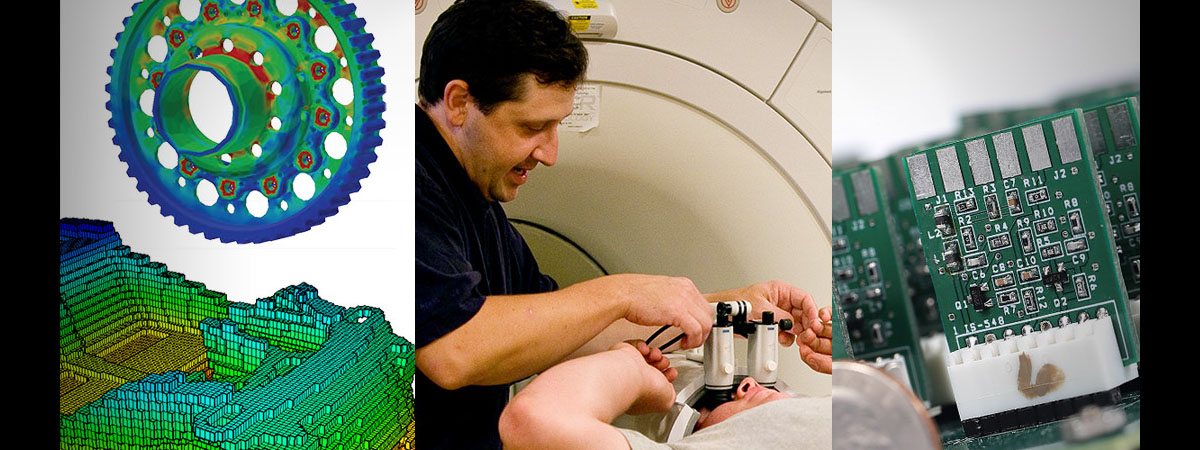Finding answers
Finding answers
| Author: | Emil Venere |
|---|---|
| Magazine Section: | Strategic Growth Initiative |
| College or School: | CoE |
| Article Type: | Section Feature |
| Page CSS: | #article-banner { background-position: center 30% !important;} |
| Feature Intro: | Purdue's College of Engineering in November named three preeminent teams to focus on research ranging from medical imaging and head trauma to advanced composite materials. |
Purdue’s College of Engineering has named three preeminent teams to focus on research ranging from medical imaging and head trauma to advanced composite materials.
The effort is part of the college’s strategic growth plan, which will add as many as 107 faculty over five years. It is also part of Purdue Moves, a range of initiatives designed to broaden Purdue’s global impact and enhance educational opportunities for its students. Three groups were selected from 17 participating teams, comprising more than 110 faculty members. In total over the three years of the competition, 76 teams have participated and a total of 11 were chosen.
“The preeminent teams represent a faculty hiring strategy focused on research and complements our discipline-based faculty hiring,” says Leah Jamieson, the John A. Edwardson Dean of Engineering. “These teams have the potential to build dramatically on Purdue’s current strengths with strategic hires. Their research will have far-reaching impact.”

(Discovery Park photo)
‘Label-free’ spectroscopic sensing, an emerging platform for biology and medicine
Label-free imaging does not require the use of fluorescent dyes or other preparations to detect structures and features. Because processing kills the tissue and is time-consuming to perform, the label-free technology represents an alternative approach that allows the study of unaltered living tissues and cells, making for more rapid and accurate findings.
The multidisciplinary team is led by Ji-Xin Cheng, professor of biomedical engineering and chemistry and scientific director of the Label-free Imaging lab at Purdue’s Discovery Park. The effort will harness research from several groups in areas as diverse as electrical engineering, chemistry, biology and medicine.
Advances in imaging technology could make it possible to quickly reveal precise molecular and chemical information about tissue, providing faster and more accurate diagnoses of conditions including cardiovascular disease and cancer. The technologies will include harnessing ultrasound signals from molecules exposed to a fast-pulsing laser and advanced nonlinear Raman imaging technology capable of near instantaneous measurements of living tissue.

(Purdue University photo/John Underwood)
Composites manufacturing for industries - including aerospace and automotive
New materials could bring innovations including superior jet engines that are lighter, more powerful and fuel-efficient than today’s power plants. The team will consist of faculty from areas of expertise spanning materials engineering to aviation technology, and the work will include advanced molecular-scale modeling and research into polymers, composites and carbon nanomaterials.
Automotive industry manufacturing is undergoing a transformation that is crucial to Indiana and the nation, says R. Byron Pipes, the John Leighton Bray Distinguished Professor of Engineering, who is leading the team.
Purdue is already part of a diverse team selected by the U.S. Department of Energy to develop energy-efficient vehicles and wind energy and compressed-gas storage technologies. Under that program, the University was selected to participate in the Institute for Advanced Composites Manufacturing Innovation (IACMI) to direct a five-year effort with a $70 million federal commitment from the DOE.
The University also has recently formed a Composites Design and Manufacturing HUB, a platform for the browser-based composites learning community of 1,400 users. A second hub, the Composites Virtual Factory HUB, is being used to deploy and integrate simulation tools that capture the manufacturing processes under development in the other IACMI technology areas. In partnership with Oak Ridge National Laboratory, Purdue will develop advanced manufacturing simulations.

(Purdue University photo/Andrew Hancock)
Engineering healthier brains through the assessment, treatment and prevention of neurophysiologic injury and disease
The team is led by Thomas M. Talavage, professor of electrical and computer engineering and biomedical engineering; founding co-director of the Purdue MRI Facility.
Purdue researchers were first to demonstrate that brain physiology can be altered by repeated nonconcussive blows to the head, even in the absence of clinical symptoms. The researchers have shown that medical imaging technologies can be used to reliably quantify injury to the brain.
The research aims to generate new clinical approaches by better understanding the underlying neuropathology of brain injury. Data from various imaging technologies will be used to model both normal and injury states and to identify imaging and biochemical markers for injury. Researchers in the Purdue Neurotrauma Group have pioneered the study of subconcussive injury and are recognized leaders in brain injury research.
The team also is developing new protective technologies such as more effective energy-absorbing materials for football helmets, which have been licensed through the Office of Technology Commercialization. The team also was instrumental in forming a new Concussion Neuroimaging Consortium with researchers at the University of Central Florida, Michigan State University, University of Nebraska, Northshore University Hospital, Northwestern University, Ohio State University and Penn State University.

Comments